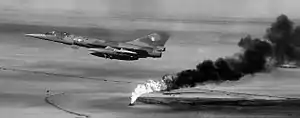Escadron de Chasse 1/4 Gascogne
Escadron de Chasse 1/4 Gascogne (Fighter Squadron 1/4 Gascogne) is a squadron of the French Air and Space Force (Armée de l'air et de l'espace). It is equipped with Dassault Rafale and is the second unit of the French Air and Space Force to receive that aircraft.
| Fighter Squadron 1/4 Gascogne | |
|---|---|
| Escadron de Chasse 1/4 Gascogne | |
 Mirage IV at Kleine Brogel Air Base, Belgium 2005 | |
| Active | April 1, 1937 - present |
| Country | |
| Branch | |
| Type | Nuclear strike |
| Role | Force de dissuasion (Nuclear deterrence) |
| Part of | Strategic Air Forces 4e Escadre de Chasse |
| Garrison/HQ | BA 113 Saint-Dizier – Robinson Air Base |
| Aircraft flown | |
| Fighter | Dassault Rafale |
The 1/91 Gascogne is attached since August 26, 2015 to the 4e Escadre de Chasse which was reformed the same day.[1]
%252C_Base_a%C3%A9rienne_118_Mont-de-Marsan%252C_1986.jpg.webp)
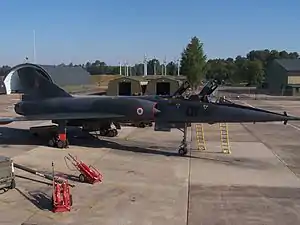
History
The time of peace (1918-1939) and the constitution of Group II/19
Groupe de Bombardement II/19, created on April 1, 1937, originates from two First World War Escadrilles (flights) SAL 28 and Escadrille Spa.79. In 1932, these two units constituted the Escadrilles of an Aerial Base : 1st Escadrille, commanded by Captain Barthe, and the 2nd Escadrille of Captain Perronneau equipped respectively with Nieuport 622, Breguet 19 and Breguet 19.B.2. Charged with leading bombardment and firing experiences, these formations gave birth in March 1933 to a specialized escadrille in night reconnaissance (1st escadrille) and another (2nd escadrille), destined for day reconnaissance. Four months later, a Ministerial note allowed these units to re-adopt the traditions of the SAL 28 and SPA 79, which the insignias were respectively a Nile elephant and a wolf head in profile. Integrated into the grand reconnaissance group of Cazeaux, the latter were equipped with Potez 25 and ANF Les Mureaux 113R.2 in January 1935, to be transformed a couple months later to Potez 540.
Then in October 1936, the Group Cazaux became a bombardment unit, and joined accordingly in January 1937, an Aerial Base, where the latter joined on April 1 of the same year the 19e Escadre, under the designation of GB II/19. During the same time, this formation commenced to transfer, without grave problems, on the Bloch MB.210. In May 1939, the latter took the North African route, in order to conduct bombardment exercises. Transited by Tunis El Aouina, the group reached Oran on the 20th of the same month, then, went to Ksar Es-Souk, Morocco. On August 26, the II/19 rallied Sétif, in light of facing (French: faire face) any Italian aggression in Tunisia.
With no state of belligerency declared with that country, the Group was brought back to Blida towards the end of September 1939 and garrisoned the following month at Biskra, where the latter formed with the 61e Escadre, the Instruction Group n°2. In March 1940, one escadrille II/19 was on its way to Morocco in order to test the Douglas DB-7, upon which high command was counting to transform the bombardment group with. Passage on this new equipment took place between April and May, and at the middle of the month, the II/19 went came back and joined France, where the Germans had launched their grand offensive.
On May 20, the group was found at an Aerial Base in Évreux. Two days later, the group's war missions commenced, in occurrence against columns of the enemy which was borrowing the route from Cambrai to Bohain. Sorties succeeded each other and towards the end of the month, were being conducted (sorties) on the region of Abbeville and Somme, and equally on Ham and Saint-Quentin. On June 2, the Group was transferred towards the field of Pithiviers, from which the latter pursued as of the 5, missions against German forces launched in attacks on the front of Somme and Aisne. With the advancing of the enemy becoming menacing, the II/19 rallied on June 11 at the Aerial Base of Subdray, between Bourges and Saint-Florent-sur-Cher, then made way on Agen (June 15), and finally by Lézignan (fr), to North Africa. Arrived to Blida, the II/19 made way towards Souk El Arba on June 21 and readied to bombard Sardinia, while Italy entered the war a couple of days later. An expedition on Cagliari was ordered to step down, in reason of the vigorous entry of the Armistice, on June 25, with Germany and Italy.
From the armistice to the entry in war with the Allies (20/06/1940 -25/05/1944)
Maintained in activity at the corps of the Armistice Air Force, the GB II/19 was placed on an alert phase after the British attacks against Mers el-Kébir, in July 1940. On August of the same year, the unit made way by Meknes in Morocco, in order to assault Gibraltar. That mission being canceled, the Group went back to Blida, the latter becoming the base garrison. While recompleting formations, the latter received another designation as a light bombardment group - Groupe de Bombardement Léger I/19 on September 1, 1940, while the 3rd and 4th Escadrilles became respectively the 1st and 2nd Escadrilles. On September 23 and 25, the Group partook in attacks led against Gibraltar, then went back to Blida. When the Allied disembarking in North Africa took place, in November 1942, the Group did not participate, but a little to the resistance, which opposed the Vichy Army (French: Armée de Vichy) to the Anglo-Americans. Based at Rovigo, the group waited for rearmament to take place by the Allies and was transferred to Colomb-Béchar at the beginning of January 1943. The Group underwent a long training session until October of the same year, époque where the latter was dissociated, certain elements expedited to Constantine (1st Escadrille), the others to Sétif (2nd Escadrille).
A little later began a training course on Martin B-26 Marauder, and on February 21, 1944, the I/19 took the denomination of bombardment group - Groupe de Bombardement Moyen I/19 GASCOGNE.
Having pursued training on the Martin B-26 all along the months of February and March, the group made way April 1, 1944 on the field of Chateaudun-du-Rhumel and formed a Bombardment Squadron with the Bretagne Bombardment Group (French: groupe Bretagne) and the GBM 1/22 Morocco, already engaged in operations.
Campaign of Italy
Commanded by Commandant Secrétan, the GBM I/19 went on to Sardinia, which was in the hands of the Allies, on May 15 and conducted the first war mission one month later, by attacking communication routes in the region of La Spezia, in Italy. Sorties accordingly commenced, while targeting bridges, railways, train stations, and various routes situated on the Italian Peninsula. Sorties took place all along the months of June and July before orienting, as of August, on the midi of France in prevision to the disembarking in Provence. The first mission on the metropolitan territory was accomplished on the 2 of the same month, and during the second mission, on August 4 and 15, the B-26 of Gascogne engaged at the connecting bridge of Sisteron. Accordingly, then, the activity of the I/19 was shared between France and Italy.
Campaign of Germany
At the beginning of October, the Group rallied the midi and garrisoned in a first phase at an Aerial Base in Istres. The latter went about Lyon-Bron as of mid-November in order to take part in operations in the east of the country. The first mission led on Germany had lieu on November 17 and aimed the rail bridge of Neuenburg, on the Rhine, between Mulhouse and Colmar. The objectives which were in definition at the I/19 revolved around bridges, train stations and even garrisons. The unfavorable climatic conditions which reigned in January, February, and March 1945 slowed the sorties, and on March 19, the GBM I/19 conducted the last mission since Lyon-Bron. The latter went on to an Aerial Base and pursued actions on Germany until the middle of the month of April, époque during which the group participated in raids against the Royan Pocket and Pointe de Grave (French: poche de Royan et de la pointe de Grave), held by the Germans since August 1944. The Royan Pocket being reduced, the Group retook sorties on Germany until the end of hostilities.
Dissolution of the Group
Stationed in France during a couple of months, the I/19 garrisoned at Mengen, in Germany, in September 1945 and was dissolved in April 1946, while under command of commandant Forget.
Reconstitution and Indochina War
The unit was reconstituted in January 1951 under the designation of I/19 Gascogne in light of participation to operations in Indochina.
The unit was officially reconstituted in Indochina, under the designation of Groupe de Bombardement I/19 Gascogne, and based at Tourane. Equipped with Douglas B-26 Invader and under the command of René Chesnais (French: René Chesnais), the Group conducted numerous operational sorties on Annam and was engaged in Tonkin at the beginning of 1954, participating notably to the Battle of Dien Bien Phu. Still garrisoned at Tourane at the end of the Indochina War, the Gascogne continued to train and was dissolved on November 1, 1955. During that campaign, more than 21,000 hours in the air were flown, near 13,000 tons of bombs were dropped and 9 equipment were lost.
2nd Reconstitution and the Algerian War
The unit was recreated on September 1, 1956 at Bône, under the designation of Groupe de Bombardement 1/91, and took part to the Algerian conflict. On Aerial Base Bône-les-Salines, the Group received the colors (group flag) during a ceremony presided by Armed Forces State Air Secretary, M. Laforest and Général Bailly, on June 20, 1957. Numerous operations were conducted conjointly with the Escadron de Chasse of the French Air Force stationed in North Africa and the Aéronavale.
The 1/91 Gascogne accomplished more than 9000 missions representing 24,000 sorties until 1962 and totalized 44,300 hours of flying. Repatriated to Bordeaux when hostilities took end on the Algerian territory, the Gascogne was again dissolved on September 17, 1962.
3rd Reconstitution & Nuclear Era
The Bombardment Squadron - Escadron de Bombardement 1/91 Gascogne was reformed on an Aerial Base on June 1, 1964. The unit was the first squadron with a nuclear capacity, armed with Mirage IV, and was declared operational as the following October. « Gascogne » was in charge of executing a real nuclear test trial at the Experimentation Center of the Pacific (French: Centre d'expérimentation du Pacifique). In fact, on July 19, 1966, after taking off from an Aerial Base in French Polynesia, the arm was dropped at 0505 local time, without any problem. In order to arrive to that simple result, Gascogne had trained extensively to long distance missions with supersonic bombardment capabilities at high altitude. Accordingly, the latter simultaneously, was tasked with maintaining operational alert awareness by fixed means determined by the operational center of the Strategic Air Forces (FAS).
In February 1965, a decision by the general staff headquarters of the French Air Force (EMAA) authorized the Escadron/Squadron I/91 « GASCOGNE » to wear the attributed color Fourragere of the predecessor unit, the Groupe de Bombardement I/91 « GASCOGNE ».
On May 10, 1966, it was a Mirage IVA n°36 of Escadron 1/91 "Gascogne" which conducted the first transatlantic cross over with a combat aircraft at French reaction under the command of Commandant Dubroca and Captain Caubert in 7h40, from an Aerial Base. That voyage took 3 Air Supply Aircraft enough to rally the town of Boston.[2]
In 1968, FAS turned towards low altitude bombardment which became the principal mission of the Squadron, the supersonic bombardment was only retained as a replacing bombardment alternative.

In 1986, EB 1/91 became the first operational squadron of an arms system Mirage IVP ASMP and consisted of 7 to 8 Mirage IVP.
In September 1992, following the dissolution of the Escadron de Reconnaissance et d’Instruction 01.328 (reconnaissance and instruction squadron) at Bordeaux. The unit inherited the mission of strategic reconnaissance.
In the Spring of 1994, the unit participated to Operation Crécerelle of maintaining peace in Bosnia-Herzegovina by conducting several photographic reconnaissance missions on top of the geographical territory.
End of the Mirage IV
In 1996, the general staff headquarters of the FAS decided that the Mirage 2000N would be the only units to assure nuclear missions. The Mirage IVP had accordingly one mission: The distant strategic reconnaissance which would be authorized, with air supply, the singular endurance of Mirage IV. On July 1, 1996, EB 1/91 became Strategic Reconnaissance Squadron, (French: Escadron de Reconnaissance Stratégique, ERS). Equipped with photographic container types and different cameras gauges, the Gascogne executed since 1968 several important reconnaissance missions such as the one in Tchad in 1974. Other missions such as CONDOR in 1996 and 1997 since Djibouti on top of the Hanish Islands in the Red Sea, ALADIN in Iraq in 1998, HÉRACLES in 2001-2002 following the September 11 attacks, finally TARPAN in 2003 for surveillance missions on top of the Iraqi territory, have all demonstrated the primordial functions of the Strategic Reconnaissance Squadron (ERS) while the world faced international menaces.
On June 23, 2005, the Mirage IV P n°59 conducted the last flight of Mirage IV of the Squadron and the French Air Force, at the command of a commandant, operations chief of Gascogne. This equipment is exposed today on an Aerial Base.[3]
The ERS was dissolved on June 23, 2005 at an Aerial Base.
The Escadron de chasse 1/91 Gascogne was credited to dropping 120 bombs and conducted 368 missions in Libya during Opération Harmattan.[4]
On Rafale
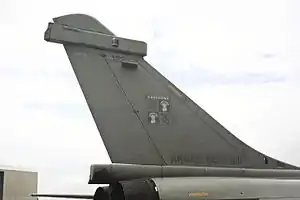
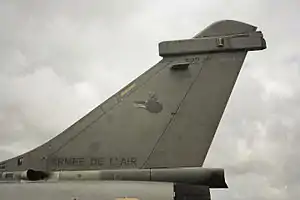
The escadron/squadron was reformed on March 31, 2009 on an Aerial Base. Equipped with Rafale, the unit integrated the Strategic Air Forces. From August 31, 2015 until September 18, 2015, 15 Rafale of the Escadron de chasse 1/7 Provence, Escadron de Chasse 2/30 Normandie-Niemen, and the 1/91 Gascogne were deployed from an Aerial Base to conduct an air-to-air campaign.[5]
Operation Tamouré
On May 10, 1966, at 0900 local time, one Mirage IV and one C-135 deployed from an Aerial Base. They landed at 0740 at Bosotn-Otis. After a layover at Sacramento and Honolulu, they joined an Aerial Base.
Another Mirage IV was supplied, by maritime means, towards Hao. The two equipment were placed in operational conditioning. The first Mirage IV was damaged during a short landing.
On July 19, 1966, the second Mirage IV assumed the alert awareness at 0000 hours. The authorization of a test trial was given, the explosion of the first atomic bomb, AN-22, fired from a Mirage IV, had lieu at 0505 local time, as in 1605 Paris time.
On July 25, the Mirage IV and the C-135F left Hao for the same itinerary and landed at night, on July 28 at an Aerial Base in France.
Decorations of the Gascogne
For the First World War :
- SAL 28 : one citation at the orders of the Army, one citation at the orders of the Division;
- SPA 79 : no citation;
- BR 66 : four citations at the orders of the Army, and Fourragere with colors of the Médaille Militaire;
- SPA 37 : one citation at the orders of the Army.
For the Second World War :
- GBM I/19 GASCOGNE obtained during the course of second campaign of France two citations at the orders of the army and the Fourragere with colors of the Croix de Guerre 1939-1945.
For the Indochina War:
- GB I/19 GASCOGNE obtained six citations at the orders of the army and the Fourragere with colors of the Légion d'honneur with olive at colors of the ruban of Croix de guerre des théâtres d'opérations extérieures (TOE).
For Operation Trident (Balkans, 1999):
- ERS 1/91 GASCOGNE obtained a citation at the order of the Aerial Brigade with title of the TOE.
For Operation Harmattan then Unified protector (2011):
- EC 1/91 Gascogne obtained a cross a citation at the orders of the Aerial Army.[6]
For Operation Serval (2013):
- EC 1/91 Gascogne obtained a cross a citation at the orders of the Aerial Army.
On January 1, 2016, the Fanion of the Escadron de Chasse Gascogne is then titular:
- Croix de Guerre 1939-1945 with two bronze palms;
- Croix de guerre des théâtres d'opérations extérieures with six bronze palms and one bronze star;
- Cross for Military Valour with two bronze stars.
Esadrille
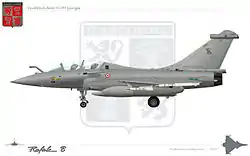
Escadrille « Salmson 28 »
The Escadrille 28 was created on September 1, 1914 at the retrench camp of Paris, using Farman MF.11s. The latter took the designation of HF 28. Engaged in combats at Picardie, the latter was credited of a first aerial victory on October 24. The Escadrille went back to Saint-Cyr on January 8, 1915 to be equipped with Caudron G3. The unit took the designation of Escadrille C 28.
In 1917, the unit received the Sopwith 1 1⁄2 Strutter built by France and became the SOP 28. On August 31, 1917, the unit was cited at the orders of the Division for having accomplished with audacity, important reconnaissance missions, of regulating procedures and accompanying the infantry.
On January 26, 1918, the unit took the designation of SAL 28, operating then on the Salmson 2. The unit was the observation escadrille of the Second Army Corps (French: 2e Corps d'Armée). On January 31, the unit was cited again, at the orders of the Army this time, for participation in the Battle of Verdun. The unit was engaged in combats at Somme, Lorraine, and Argonne.
During existence, the unit acquired 7 confirmed aerial victories (and 2 unconfirmed) on the Germans. 18 pilots and observers lost their life in operations. Thirteen were wounded. Two were made prisoners. The unit was dissolved in July 1919 at Saint-Mihiel.
- Symbolic
End of 1917, the Escadrille 28 chose as an insignia, an elephant, which was painted under three different models, which one inspired the paper cigarette publicity « le Nil » representing an elephant with a head turned. The insignia was painted by Lieutenant Asnard, pilot and painter.
- decorations of SAL28
- 1 citation at the orders of the Army
- 1 citation at the orders of the Division
- Croix de guerre 1914–1918 with bronze palm and a silver star
Escadrille « SPA 79 »
Constituted during the month of November 1916, escadrille number 79 was first equipped of Nieuport sesquiplanes, hence the initial designation of N 79. The unit would conserve this equipment during two years before perceiving SPAD 7 and SPAD 13, becoming accordingly the SPA 79 and 19 in January 1918. From that date, the escadrille commenced movement activity. The unit conducted numerous Hunter Patrols (French: Patrouille de Chasse), protection patrols, missions of photographic reconnaissance and machine gunning the trenches, columns and enemy convoys.
At the Armistice, the unit acquired 8 confirmed aerial victories, out of which 7 against aircraft and 1 against a Drachen.
The unit was dissolved on March 12, 1919.
- Symbolic,
The insignia of the Escadrille 79 represents the head of a wolf, either black or brown.
Escadrille « BR 66 »

Created officially on October 15, 1915, the escadrille C66 utilized Caudron G.4. As of 1916, the escadrille received Sopwith and was accordingly designated as SOP 66. In October 1917, the unit became the BR 66 with the arrival of the Breguet 14 B2.
The BR 66 is an escadrille with a prestigious past: titled with four citations at the orders of the Army for the title of the First World War, with the Fourragere with colors of the Médaille Militaire.
The BR 66 is titled with 10 confirmed aerial victories.
- Symbolic
Captain de Kerillis, commandant of SOP 66, chose in March 1916, as an insignia, the Egyptian Falcon in front vue, with deployed wings, often placed on a Sun, and painted by Sergent Rapin, pilot in the Escadrille.
Escadrille « SPA 37 »
Reconnaissance escadrille constituted on January 23, 1915 at Châteaufort under the command of Captain Quillien and equipped with Morane-Saulnier L. Placed at the disposition of the Third Army (French: 3e Armée) in February 1915, the unit operated on Argonne from Sainte-Menehould. The unit received the first Nieuport as of July 1915, passed from ten to twelve pilots and participated to the offensive of Champagne. Re-baptized N37 on September 20, 1915, the unit left the field of Pierrefitte for Meltette, and as of 1916, participated to operations of Verdun. Beginning April 1916, Captain Quillien was beaten down and replaced with Captain Feiestein, while the first Nieuport 11 « Bébé » arrived, accordingly transforming the N 37 in an offensive combat escadrille. On July 2, escadrille 37 was put at disposition of the Sixth Army (French: 6e Armée) on the Battle of the Somme and moved to Cachy. Simultaneously, the unit integrated the Combat Group GC 12. The unit lost 13 pilots during 1916.
Re-passing under the control of the Third Army (French: 3e Armée), the unit made movement on Plessis on January 25, 1917, rejoining the GC 13 which the unit abandoned on March 7 for the GC 15 and field of Cheppe, put at the disposition of the Fourth Army (French: 4e Armée). The unit accordingly received the first SPAD, and to singularize the aircraft of his escadrille at the corps of GC 15, Captain Feierstein decided to replace the individual white letters painted in a white circle on the sides of the Nieuport by a Condor in flight. This volatile colors and forms numerous times.
After having participated to operations in Champagne, SPA 37 (since May 1917) operated on the Verdun front (French: front de Verdun) from July 26, 1917 until February 10, 1918. Captain de Bonnevay, which assumed command of the unit on December 20, 1917, was replaced on February 5, 1918 by Captain Paumier. A couple of days later the escadrille made way by Beauzée and was engaged in operations destined in containing the new German offensive in the Aisne and Somme. On May 29, 1918, the unit made movement towards Raray, where a bombardment endured the loss of three victims, out of which Captain Paumier. He was replaced by Captain Poupon while the Hunter Pilots (French: Pilote de Chasse) were hunting a Drachen (Observation balloon) in the sector of the Chemin des Dames.
Unfolded on Roissy-en-France for reorganization, the unit was again at Champagne on June and July 1918 (Tenth Army), then on Marne, and on the north-east front in September (Tenth Army (French: 10e Armée). Stationed at Nancy-Ochey, the latter supported a United States Army (U.S.) formation during the offensive of Saint-Mihiel (French: offensives sur Saint-Mihiel) and on Meuse. Unfolded at Melete on November 11, 1918, SPA 37 titled 85 victories, out of which 50 confirmed. During the war, the unit counted in the ranks lieutenant Bernard Barny de Romanet (18 victories out of which 10 for the escadrille), sous-lieutenant Fernand Guyou (12 victories), Captain Roger Poupon (8 victories), sergent Coupillaud (6 victories), sous-lieutenant Lienhart (6 victories), but also a pilot of Chinese nationality, sergent Étienne Tsu. On the next day of the Armistice, the 37th Escadrille (French: 37e Escadrille) passed to Gondreville, then Azelot on December 8. On January 1, 1920, the unit became the 2nd Escadrille of the 1st Aerial Hunter Regiment of Thionville (Ist Group). The unit was accordingly entirely equipped with SPAD S.XIII.
Becoming the 5th Escadrille (French: 5e Escadrille) of 33rd Aerial Mixed Regiment of Mayence (French: 33e Régiment Aérien Mixte de Mayence) (IInd Group) on June 1, 1924 after being reequipped with Nieuport NiD.29, then 8th Escadrille (French: 8e Escadrille) (IIIrd Group) of the 3rd Hunter Regiment (French: 3e Régiment Aérien de Chasse de Châteauroux) on July 1, 1930, the unit was re-equipped with Nieuport NiD.62 before becoming the 4th Escadrille (French: 4e Escadrille) of the GC II/3 on September 19, 1933. The history of the unit then accordingly merged with the history of the group. On July 1, 1947, the Hunter Group II/3 (French: Groupe de Chasse II/3) was dissolved, and replaced with the Escadron de Chasse 1/4 Dauphiné. The Dauphiné was dissolved in July 2010.
On June 25, 2012, the Escadrille was reborn at the 1/91 "Gascogne" on a designated Aerial Base.
Designations
- Groupe de Bombardement II/19 : April 1, 1937 - September 1, 1940, (GB II/19)
- Groupe de Bombardement Léger I/19 : September 1, 1940 - February 21, 1944, (GBL I/19)
- Groupe de Bombardement Moyen I/19 : February 21, 1944 - April 1946, (GBM I/19)
- Groupe de Bombardement I/19 Gascogne : January 1951 - November 1, 1955, (GB I/19 Gascogne)
- Groupe de Bombardement 1/91 Gascogne : September 1, 1956 - September 17, 1962, (GB 1/19 Gascogne)
- Escadron de Bombardement 1/91 Gascogne : June 1, 1964 - July 1, 1996, (EB 1/91 Gascogne)
- Escadron de Reconnaissance Stratégique 1/91 Gascogne : July 1, 1996 - June 23, 2005, (ERS 1/91 Gascogne)
- Escadron de Chasse 1/91 Gascogne : March 31, 2009 - September 1, 2016, (EC 1/91 Gascogne)
- Escadron de Chasse 1/4 Gascogne : since September 1, 2016 (EC 1/4 Gascogne)
Bases
- Aerial Base (1951-1955)
- Aerial Base (1956-1962)
- Aerial Base (1962)
- Aerial Base (1964-2005)
- Aerial Base (since 2009)
Equipment
- Martin B-26 Marauder (1944-1946)
- Douglas A-26 Invader (1951-1962)
- Dassault Mirage IVA then IVP (1964-2005)
- Dassault Rafale (since 2009)
See also
Notes
| Wikimedia Commons has media related to 1/91 Gascogne. |
- http://www.defense.gouv.fr/air/actus-air/nouvelles-escadres-aeriennes-une-coherence-operationnelle-accrue-des-valeurs-renforcees
- ,, May 12, 2017, July 14, 2017
- http://www.defense.gouv.fr/air/actus-air/il-y-a-dix-ans-dernier-vol-du-mirage-iv
- Des tableaux de chasse éloquents, Le Mamouth
- http://www.defense.gouv.fr/air/actus-air/rafale-en-campagne-sur-l-ile-de-beaute
- "Attribution de Croix de la valeur militaire". Archived from the original on 2013-12-15. Retrieved 2018-01-14.
References
- Bailey, Frank W. & Cony, Christophe (November 2001). "L'escadrille Spa 79 durant la Grande Guerre" [Escadrille Spa 79 During the Great War]. Avions: Toute l'Aéronautique et son histoire (in French) (104): 19–24. ISSN 1243-8650.
- Bailey, Frank W. & Cony, Christophe (December 2001). "L'escadrille Spa 79 durant la Grande Guerre". Avions: Toute l'Aéronautique et son histoire (in French) (105): 30–35. ISSN 1243-8650.
- Bailey, Frank W. & Cony, Christophe (February 2002). "L'escadrille Spa 79 durant la Grande Guerre". Avions: Toute l'Aéronautique et son histoire (in French) (107): 17–24. ISSN 1243-8650.
- Grolleau, Henri-Pierre. « Rafale F3 : la polyvalence », Air Fan, no 367, juin 2009, p. 37 to 40 (ISSN 0223-0038)
- Persyn, Lionel (April 1999). "Album-photos: sur B-26 Marauder au "Gascogne"" [Photo-Album: The B-26 Marauders of "Gascogne"]. Avions: Toute l'aéronautique et son histoire (in French) (73): 27–29. ISSN 1243-8650.
External links
- Site officiel l'Escadron de Chasse 01.091 Gascogne (Official Website of Escadron de Chasse 01.091)
- site Armée de l'air de L'escadron de bombardement 01/091
